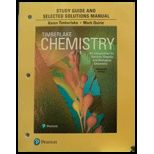
Study Guide And Selected Solutions Manual For Chemistry Format: Paperback
13th Edition
ISBN: 9780134553986
Author: Timberlake, Karen C
Publisher: Prentice Hall
expand_more
expand_more
format_list_bulleted
Concept explainers
Textbook Question
thumb_up100%
Chapter 1.2, Problem 1.10PP
Identify each of the following as an observation, a hvpothesis, an experiment, or a conclusion:
a. Sally thinks she may be allergic to shrimp.
b. Yesterday, one hour after Sally ate a shrimp salad, she broke out in hives.
c. Today, Sally had some soup that contained shrimp, but she did not break out in hives.
d. Sally realizes that she does not have an allergy to shrimp.
Expert Solution & Answer
Want to see the full answer?
Check out a sample textbook solution
Students have asked these similar questions
What is the net ionic equation for the reaction between tin(IV) sulfide and nitric acid?
The combustion of 28.8 g of NH3 consumes exactly _____ g of O2.
4 NH3 + 7 O2 ----> 4 NO2 + 6 H2O
What is the molecular formula of the bond-line structure shown below
OH
HO
○ C14H12O2
○ C16H14O2
○ C16H12O2
O C14H14O2
Chapter 1 Solutions
Study Guide And Selected Solutions Manual For Chemistry Format: Paperback
Ch. 1.1 - Write a one-sentence definition for each of the...Ch. 1.1 - Ask two of your friends (not in class) to define...Ch. 1.1 - Obtain a bottle of multivitamins and read the list...Ch. 1.1 - Prob. 1.4PPCh. 1.1 - Read the labels on some items found in your...Ch. 1.2 - Read the labels on products used to wash your...Ch. 1.2 - 1.7 Identify each activity, a to f, as...Ch. 1.2 - Identify each activity, a to f as an observation,...Ch. 1.2 - Prob. 1.9PPCh. 1.2 - Identify each of the following as an observation,...
Ch. 1.3 - Prob. 1.11PPCh. 1.3 - What are four things that would make it difficult...Ch. 1.3 - Prob. 1.13PPCh. 1.3 - 1.14 A student in your class asks you for advice...Ch. 1.4 - What is the place value for the bold digit? a....Ch. 1.4 - What is the place value for the bold digit? a....Ch. 1.4 - 1.17 Evaluate each of the following:
a.
b.
c.
Ch. 1.4 - Prob. 1.18PPCh. 1.4 - Prob. 1.19PPCh. 1.4 - Prob. 1.20PPCh. 1.4 - 1.21 Solve each of the following for a:
a.
b.
Ch. 1.4 - 1.2 Ask two of your friends (not in this class) to...Ch. 1.4 - Prob. 1.23PPCh. 1.4 -
1.24
a. What is measured on the horizontal axis?...Ch. 1.5 - Prob. 1.25PPCh. 1.5 - Write each of the following in scientific...Ch. 1.5 - Prob. 1.27PPCh. 1.5 - Prob. 1.28PPCh. 1.5 - Prob. 1.29PPCh. 1.5 - Prob. 1.30PPCh. 1 - Prob. 1.31UTCCh. 1 - Prob. 1.32UTCCh. 1 - Prob. 1.33UTCCh. 1 - Prob. 1.34UTCCh. 1 - Prob. 1.35UTCCh. 1 - Prob. 1.36UTCCh. 1 - Prob. 1.37UTCCh. 1 - 1.38 Classify each of the following statements as...Ch. 1 - Prob. 1.39APPCh. 1 - Prob. 1.40APPCh. 1 - Which of the following will help you develop a...Ch. 1 - 1.42 Which of the following will help you develop...Ch. 1 - 1.43 Evaluate each of the following:...Ch. 1 - Prob. 1.44APPCh. 1 - A bag of gumdrops contains 16 orange gumdrops, 8...Ch. 1 - Prob. 1.46APPCh. 1 - Prob. 1.47APPCh. 1 - Prob. 1.48APPCh. 1 - Identify each of the following as an observation,...Ch. 1 - Identify each of the following as an observation,...Ch. 1 - Classify each of the following as an observation,...Ch. 1 - Classify each of the following as an observation,...Ch. 1 - Prob. 1.53CPCh. 1 - Solve each of the following for z: (1.4) a....Ch. 1 - Prob. 1.55CPCh. 1 - Prob. 1.56CP
Knowledge Booster
Learn more about
Need a deep-dive on the concept behind this application? Look no further. Learn more about this topic, chemistry and related others by exploring similar questions and additional content below.Similar questions
- Check all molecules that are acids on the list below. H2CO3 HC2H3O2 C6H5NH2 HNO3 NH3arrow_forwardFrom the given compound, choose the proton that best fits each given description. a CH2 CH 2 Cl b с CH2 F Most shielded: (Choose one) Least shielded: (Choose one) Highest chemical shift: (Choose one) Lowest chemical shift: (Choose one) ×arrow_forwardConsider this molecule: How many H atoms are in this molecule? How many different signals could be found in its 1H NMR spectrum? Note: A multiplet is considered one signal.arrow_forward
- For each of the given mass spectrum data, identify whether the compound contains chlorine, bromine, or neither. Compound m/z of M* peak m/z of M + 2 peak ratio of M+ : M + 2 peak Which element is present? A 122 no M + 2 peak not applicable (Choose one) B 78 80 3:1 (Choose one) C 227 229 1:1 (Choose one)arrow_forwardShow transformation from reactant to product, step by step. *see imagearrow_forwardCheck the box if the molecule contains the listed item. *See imagearrow_forward
arrow_back_ios
SEE MORE QUESTIONS
arrow_forward_ios
Recommended textbooks for you
 Chemistry In FocusChemistryISBN:9781305084476Author:Tro, Nivaldo J., Neu, Don.Publisher:Cengage Learning
Chemistry In FocusChemistryISBN:9781305084476Author:Tro, Nivaldo J., Neu, Don.Publisher:Cengage Learning
 Chemistry for Today: General, Organic, and Bioche...ChemistryISBN:9781305960060Author:Spencer L. Seager, Michael R. Slabaugh, Maren S. HansenPublisher:Cengage Learning
Chemistry for Today: General, Organic, and Bioche...ChemistryISBN:9781305960060Author:Spencer L. Seager, Michael R. Slabaugh, Maren S. HansenPublisher:Cengage Learning- Chemistry: Matter and ChangeChemistryISBN:9780078746376Author:Dinah Zike, Laurel Dingrando, Nicholas Hainen, Cheryl WistromPublisher:Glencoe/McGraw-Hill School Pub Co
 Chemistry for Engineering StudentsChemistryISBN:9781337398909Author:Lawrence S. Brown, Tom HolmePublisher:Cengage Learning
Chemistry for Engineering StudentsChemistryISBN:9781337398909Author:Lawrence S. Brown, Tom HolmePublisher:Cengage Learning

Chemistry In Focus
Chemistry
ISBN:9781305084476
Author:Tro, Nivaldo J., Neu, Don.
Publisher:Cengage Learning


Chemistry for Today: General, Organic, and Bioche...
Chemistry
ISBN:9781305960060
Author:Spencer L. Seager, Michael R. Slabaugh, Maren S. Hansen
Publisher:Cengage Learning

Chemistry: Matter and Change
Chemistry
ISBN:9780078746376
Author:Dinah Zike, Laurel Dingrando, Nicholas Hainen, Cheryl Wistrom
Publisher:Glencoe/McGraw-Hill School Pub Co

Chemistry for Engineering Students
Chemistry
ISBN:9781337398909
Author:Lawrence S. Brown, Tom Holme
Publisher:Cengage Learning
Precipitation Reactions: Crash Course Chemistry #9; Author: Crash Course;https://www.youtube.com/watch?v=IIu16dy3ThI;License: Standard YouTube License, CC-BY